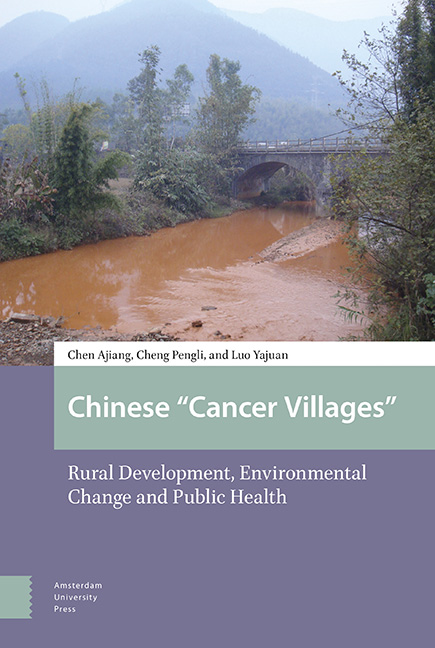Book contents
- Frontmatter
- Contents
- List of Figures, Graphs and Tables
- Acknowledgements
- Preface to the English Language Edition
- 1 Retrospective Thoughts on the ‘Cancer Village’ Phenomenon
- 2 The Ins and Outs of a ‘Cancer Village’
- 3 A Subei ‘Cancer Village’
- 4 Environmental Change and Health Risks
- 5 A Prosperous ‘Cancer Village’
- 6 Coexistence of Poverty and Cancer
- 7 Problematization and De-stigmatization
- 8 Behind the ‘High Incidence of Lung Cancer’
- 9 Villagers’ Perceptions of and Responses to the Relationship between Cancer and Pollution
- 10 Villagers Strategies for Mitigating Environmental Health Risks
- Index
- Index (Chinese) 中文索引
2 - The Ins and Outs of a ‘Cancer Village’
Published online by Cambridge University Press: 20 November 2020
- Frontmatter
- Contents
- List of Figures, Graphs and Tables
- Acknowledgements
- Preface to the English Language Edition
- 1 Retrospective Thoughts on the ‘Cancer Village’ Phenomenon
- 2 The Ins and Outs of a ‘Cancer Village’
- 3 A Subei ‘Cancer Village’
- 4 Environmental Change and Health Risks
- 5 A Prosperous ‘Cancer Village’
- 6 Coexistence of Poverty and Cancer
- 7 Problematization and De-stigmatization
- 8 Behind the ‘High Incidence of Lung Cancer’
- 9 Villagers’ Perceptions of and Responses to the Relationship between Cancer and Pollution
- 10 Villagers Strategies for Mitigating Environmental Health Risks
- Index
- Index (Chinese) 中文索引
Summary
Abstract
This chapter discusses a research site in the Huai River Basin, using the perspective of ‘ins and outs’ as an analytical framework. The pollution in Huangmengying Village mostly comes from upstream, but water conservancy projects, the nature of water courses and flows of pollution also have an impact. Media coverage of cancer in the area emphasized the role of external pollution from industry, but this study also found a relationship between smoking and cancer among men and between hepatitis B and liver cancer. There was also an association between drinking water and the high incidence of digestive tract diseases, which declined when the water supply was improved. The phenomenon of ‘cancer villages’ is therefore also shaped by the living conditions and lifestyle of the villagers.
Keywords: water courses, environment and health, lifestyle habits, internal pollution, external pollution
Introduction
If the word ‘cancer’ refers to a condition that affects only personal physical health, the term ‘cancer village’ implies a problem that goes beyond the individual. This is because the term ‘village’ refers not only to the physical and social location in which a community of people resides, but also to the community itself. In pre-modern times, rural areas of China were mainly comprised of villages and so this social unit has special significance. The phenomenon of ‘cancer villages’ has therefore become a subject of debate not only among residents of villages themselves, but also among outsiders and even the national government. ‘Cancer villages’ have also become a topic of social science research. At the same time, the problem of cancer villages can be understood from many different perspectives. These can be simply grouped into internal and external factors, in the sense that they relate to whether pollution is generated from within or outside the community and to whether illness is caused by individual behaviour or the impact of external factors, including pollution.
In medical science, it is generally considered that the risk factors for cancer include: (1) Genetic factors. The probability of getting certain types of cancer varies widely across racial groups, and men and women are prone to different cancers. (2) Diet and nutritional status.
- Type
- Chapter
- Information
- 'Chinese Cancer Villages'Rural Development, Environmental Change and Public Health, pp. 53 - 84Publisher: Amsterdam University PressPrint publication year: 2020

